Rust Family Foundation: Archaeology Grants Program
Borderlands
and Rural Landscapes in Central Asia during Antiquity (c. 3rd century
BCE – 3rd century CE): Kurgan Burials and Pastoralism at the Fringes of
Bukhara Oasis (Uzbekistan)
Principal Investigators:
Prof. Sören Stark
Shujing Wang, Ph.D.
Institute for the Study of the Ancient World, New York University
The study area of this project is the oasis of Bukhara in present-day central Uzbekistan (fig.1). The rich funerary ensemble in the peripheries of the Bukhara Oasis includes more than 1000 kurgan burials. These burials, usually associated in the region with mobile pastoralists (‘nomads’), are situated in the borderland between the intensively farmed river oasis and the desert steppes (fig. 2). Around 200 of these kurgans were excavated between the early 1950s and the late 1970s. However, the results of these excavations have been only partially reported and are inadequately studied. Most of these kurgans seem to date around the 3rd century BCE to the 3rd century CE, during which period, based on the limited historiographical source, this region has been repeatedly conquered by armies of nomadic origins.
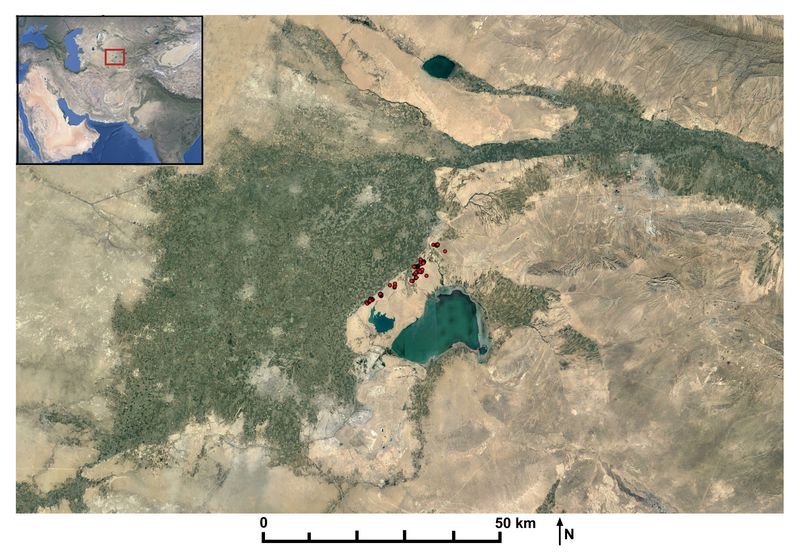
Fig.1: Location of the Bukhara oasis in central Uzbekistan. The red dots show kurgan sites found in the 2017-2018 survey.
The significance of the present project is threefold. First, this project deepens our understanding of the funerary practices in pre-modern borderland societies; it also helps to clarify how funerary practices relate to the presentation of identity, the production and consumption practices in these societies. Second, the renewed excavation improves our understanding of how ‘nomadic’ communities interacted with ‘sedentary’ ones in the borderland, and thus facilitates to overcome the outdated but still influential dichotomy of these two communities. Third, the results of these renewed works not only provides us with important new data but also enables us to better re-contextualize heritage data from earlier excavations.
Previous Research at the site.
Study of the Bukhara kurgans was renewed in 2017 with pilot excavations at the burial clusters of Kuyu-Mazar and Lyavandak. The results from 2017 by Shujing Wang demonstrated the potential of renewed excavations at these kurgan burials. Both single interment and collective burials were found, hinting at an unexpected complexity of funerary traditions in the borderland zone. A continued and systematic exploration of this complexity was the goal of the 2018 season.
Additional pedestrian survey early in the 2018 season revealed two very interesting groups of kurgan burials in Kiziltepa burial cluster. Both groups consist of one large central kurgan with many small satellite kurgans. This type of kurgan ensemble has never been investigated in the Bukhara region, nor elsewhere in southwestern Central Asia.Therefore, in 2018 we excavated 5 burials in these two unique complexes at Kiziltepa. Due to new regulations regarding the export of bone and charcoal samples out of Uzbekistan we are still awaiting the arrival of numerous samples for isotope, DNA, and C14 analyses taken during the 2018 season of excavations.
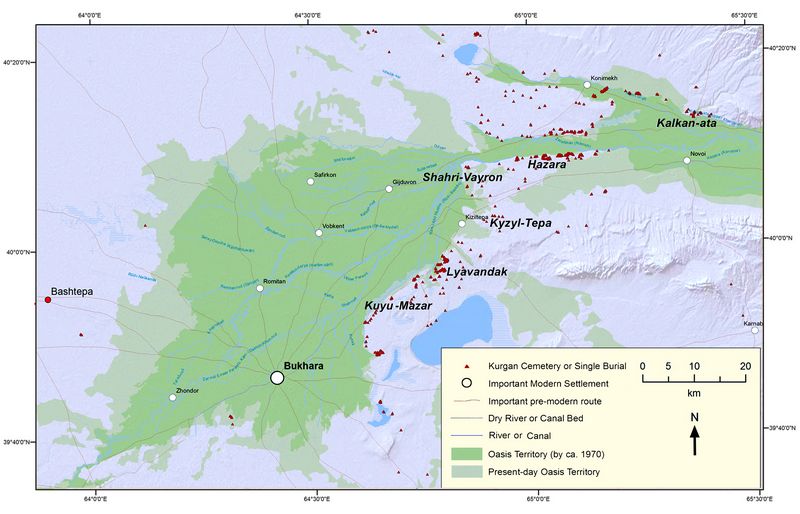
Fig.2: Map showing kurgan burial clusters in the Bukhara oasis region .
2018 Funded Research Project (RFF-2018-64)
Goals:
1) To investigate the lifestyles and sociopolitical identities of the deceased through the lens of their “funerary performance”.
1)a This goal was achieved through the archaeological excavations and through analyses of both burial goods and skeletal material.
2) To examine the exchange between pastoralists and local sedentary groups based on mortuary assemblages and excavated materials from the oasis.
2)a The analysis of mortuary practice and chemical compositional examination enabled us to meet this goal.
3) To explore the connection between the tomb occupants in the Bukhara region with those from neighboring regions during Antiquity.
3)a We have compared the funerary performance of the Bukhara region and that of the neighboring regions in order to conduct this investigation.
4) To clarify how these kurgan burials actually fit with the picture gleaned from historiographical sources.
4)a The relevant historiographical material, in particular, Chinese historical sources, has been critically reassessed as the essential reference of the historical context.
5) A systematic evaluation of the situation at each kurgan cemetery in the region with regard to their state of preservation and recent threats by looters and development projects.
5)a The archaeological survey was conducted to achieve this goal.
Methodology:
1) Archaeological Excavations and Survey
Our excavations at the kurgans are strictly stratigraphic with rigorous, total station based documentation throughout. Besides, we conducted a systematic GPS based pedestrian survey of 304 kurgans (the small red dots in fig. 1), covering an area of ca. 6 square kilometers around burial clusters Lyavandak HA, Lyavandak G2, and Kiziltepa-SC (fig.2). The location, size, and preservation of each kurgan have been comprehensively documented. Very few pottery sherds were found and collected during our survey in the survey region.
2) Bioarchaeology and Archaeobotany Analyses
All human remains from the excavation have been processed following the current standard protocols (e.g. Buikstra/Ubelaker 1994). The morphological analysis and suture closure evaluation of human bones, majorly skulls and pelvises, provided important information on the age and sex of the deceased. Evidence of burn and other posthumous treatments of human skeleton facilitated the reconstruction of body interments and relevant ritual practices. Samples of deposits from burial chambers have been analyzed in the field by R. Spengler, using flotation and wet-sieving methods with 2.0 mm and 0.5 mm sieves. Both light and heavy fractions have been sorted, counted, and identified via the microscopic analysis of morphological features.
3) Composition Analysis with pXRF (portable X-ray Fluorescence)
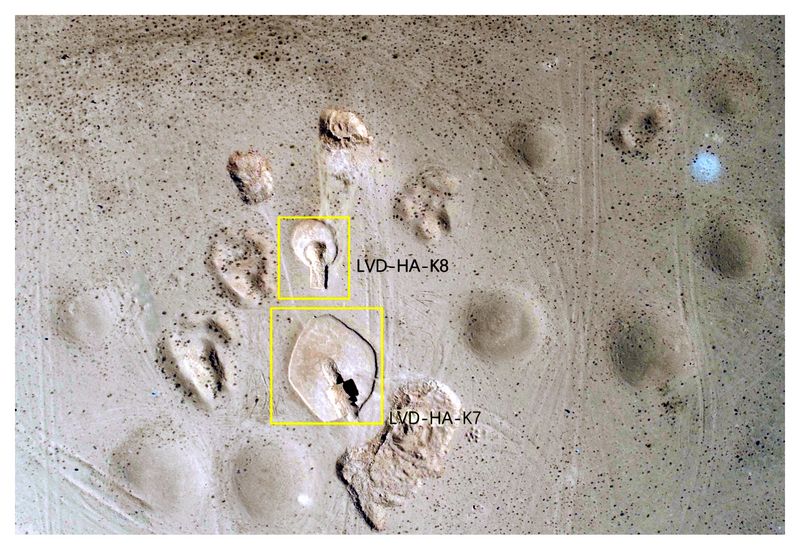 All
artifacts from new excavations and 70 objects from old excavations have
been subjected to a compositional analysis with pXRF spectrometer
(ELIO). The tested artifacts include ceramic vessels, metal tools,
weapon, glass beads, belt buckles, and other personal adornments. The
statistic analysis of these data is still in progress.
All
artifacts from new excavations and 70 objects from old excavations have
been subjected to a compositional analysis with pXRF spectrometer
(ELIO). The tested artifacts include ceramic vessels, metal tools,
weapon, glass beads, belt buckles, and other personal adornments. The
statistic analysis of these data is still in progress.Fig.3: Aerial view of Kurgan Lyavandak HA-K7 and HA-K8.
Findings:
1) Kurgan Lyavandak-HA-K7.
Kurgan Lyavandak-HA-K7 is medium in size; its oval mound was 1 m high and 13.96 m from north to south and 12.03 m from east to west (fig.3). By type it is a so-called ‘catacomb’. A roughly rectangular shaped dromos started from the center and extended southward with 4 steps leading down to the burial chamber. A wall comprising 9 layers of yellow and red mud bricks was built at the end of the dromos, blocking the entrance to the chamber. A secondary dromos was found to the south of the burial chamber. The northern end of this dromos was also blocked by a brick wall, which consisted of 2 vertical layers of dark gray bricks.
Lyavandak-HA-K7 represents a collective burial and the interments of skeletons suggest a repeatedly use of the vault (fig.4). The minimum individual number (MIN) of deceased in this burial is 9, including 3 children and 6 adults.
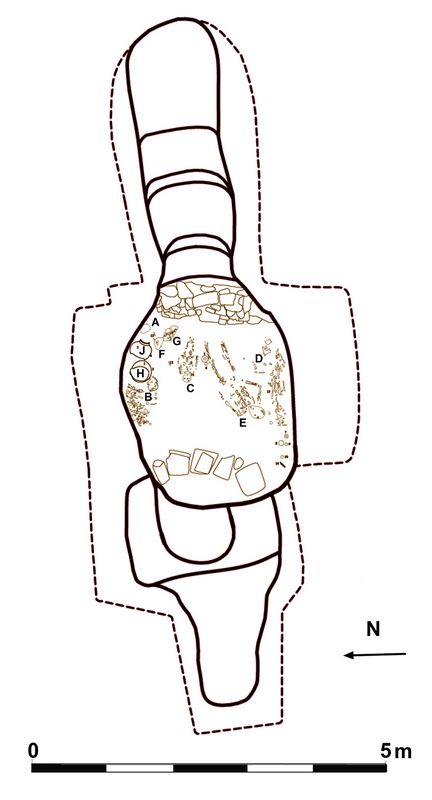 Remains
of the deceased were recovered either from the ancient floor of the
chamber itself or from ceramic repositories in the chamber. The remains
of Individuals A, B and D were found piled up at the bases of the
western and eastern walls; most likely they had been removed to the
sides of the chamber when new individuals were buried in the chamber.
Therefore, these three individuals may be the earliest deceased in this
burial. Individual F, G, H, and I were located in the ceramic containers
of bones. The ceramic repositories appeared to have been buried later,
since the base of them overlap the skull of Individual B.
Remains
of the deceased were recovered either from the ancient floor of the
chamber itself or from ceramic repositories in the chamber. The remains
of Individuals A, B and D were found piled up at the bases of the
western and eastern walls; most likely they had been removed to the
sides of the chamber when new individuals were buried in the chamber.
Therefore, these three individuals may be the earliest deceased in this
burial. Individual F, G, H, and I were located in the ceramic containers
of bones. The ceramic repositories appeared to have been buried later,
since the base of them overlap the skull of Individual B. Individual C and E were also later deceased, whose articulate skeletons were in the middle of the chamber and showed no evidence of disturbance. The burial of the later deceased should be undertaken via the southern dromos, which seems to be the only obvious access for reuse.
Fig.4: Plan of Lyavandak-HA-K7 with individual burial letters shown.
Evidence of fire was visible at many places in the chamber. Two hand-made incense burners surrounded by a large amount of charcoal were located underneath two ceramic containers for the bones. Several pinkish bones, including skulls, along the western wall seemed to be the result of burning. After removing the bones along the western wall, a dark black belt, i.e. the remains of charcoal and burning, showed up close to the bottom of the chamber on the wall. The deposit at the southwestern corner was blackish, where was located a bottom of a pot/ewer used as an incense burner. The incense burner was filled with ash and large pieces of charcoal, some of which were in the shape of small branches. Black ash was also located between Individual E and Individual D, close to the head of the former.
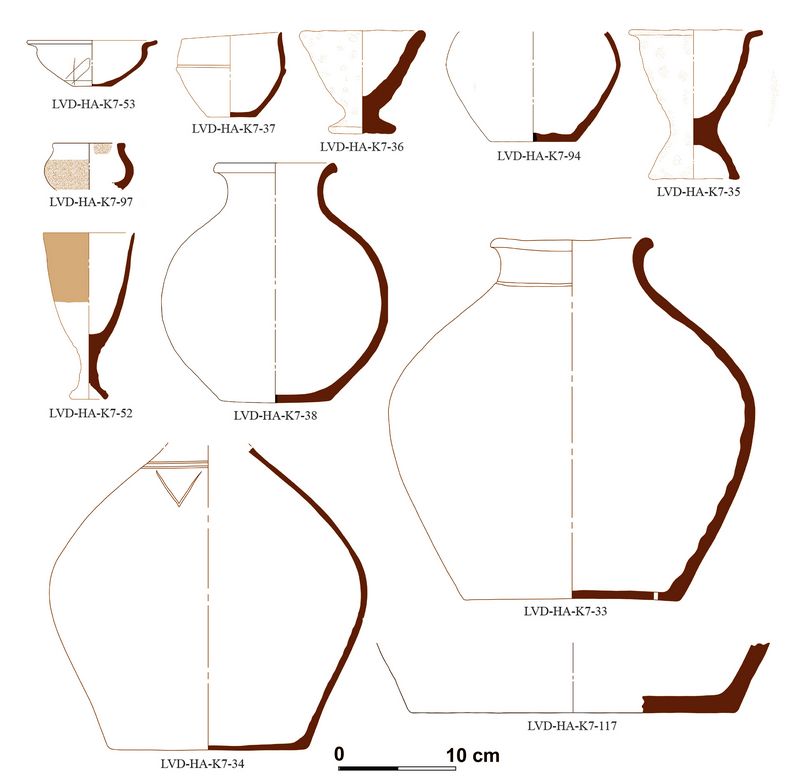
The majority of the inventory in Lyavandak-HA-K7 is pottery (fig. 5). Especially noteworthy are several wheel-made vessels of good quality. These wheel-made potteries were very possibly produced by specialized workshops somewhere inside the oasis.
Fig.5: Pottery vessels from Lyavandak-HA-K7.
They also offer additional dating hints. A relatively early date – namely between the 2nd c. BCE and the 1st c. CE (through comparison with materials from Samarkand and Bactria) – is provided by a small bowl and a goblet. The bowl was located between Individual C and E, while the goblet was located close to the southwestern corner of the chamber. The two ceramic containers for the bones (LVD-HA-K7-033 and -034) may be dated to the 2nd -4th c. CE, according to the radiocarbon dates from the charcoal beneath these two containers (collected in 2017).
Together with the human bones, ornaments, weaponry, and tools were found (fig. 6). The most prominent ornaments are a necklace (LVD-HA-K7-058) beneath
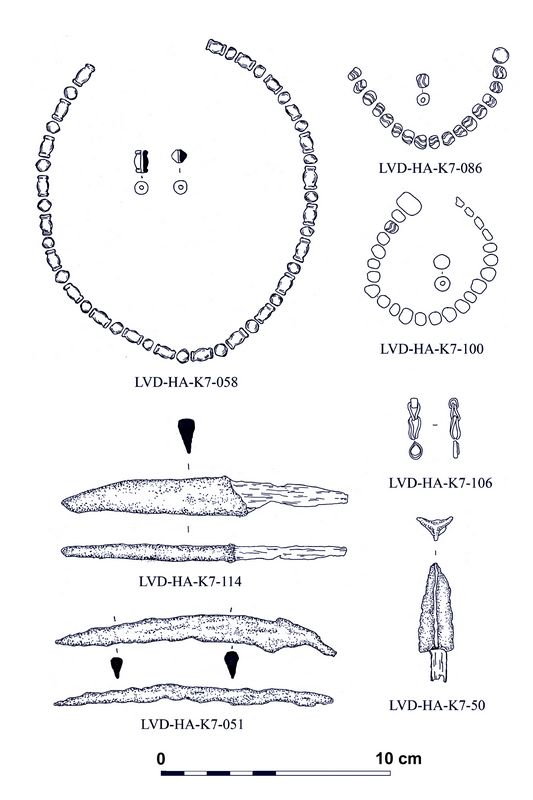 the
head of Individual C and a tear-shaped turquoise pendent
(LVD-HA-K7-106) found at the southwestern corner of the chamber. The
necklace comprises 43 black glass beads in two different shape:
cylindrical, with an engraved line close to each end; and oval. These
two beads types were alternatively arranged. The pendent was made of
a bronze framework with a tear-shaped turquoise in the
center. Similar ornaments are known from Bactria,Fergana, and even from
Xiongnu sites in Mongolia. The only weapon found in the burial is a
3-winged iron arrowhead with wooden shaft (LVD-HA-K7-050). Two iron
knives (LVD-HA-K7-051, LVD-HA-K7-114) were the only tools found in this
burial. Such arrowheads and knives have a very wide distribution
in Late Iron Age Central Eurasia.
the
head of Individual C and a tear-shaped turquoise pendent
(LVD-HA-K7-106) found at the southwestern corner of the chamber. The
necklace comprises 43 black glass beads in two different shape:
cylindrical, with an engraved line close to each end; and oval. These
two beads types were alternatively arranged. The pendent was made of
a bronze framework with a tear-shaped turquoise in the
center. Similar ornaments are known from Bactria,Fergana, and even from
Xiongnu sites in Mongolia. The only weapon found in the burial is a
3-winged iron arrowhead with wooden shaft (LVD-HA-K7-050). Two iron
knives (LVD-HA-K7-051, LVD-HA-K7-114) were the only tools found in this
burial. Such arrowheads and knives have a very wide distribution
in Late Iron Age Central Eurasia.Fig.6: Ornaments, tools, and weapon found in Lyavandak-HA-K7.
In terms of animal and botanical remains, only one astragalus of sheep/goat was found in the northwestern part of the chamber, and the result of flotation shows no grain remains from the deposit in the burial.
2) Kurgan Lyavandak-HA-K8.
Kurgan burial Lyavandak-HA-K8 is only 9 meters south to the Lyavandak-HA-K7
(fig. 3), but both the burial construction and the observed funerary rites are different. Lyavandak-HA-K8 is a small kurgan, the mound of which was 30 cm high and 7 m in diameter. It was originally a so-called ‘podboi’ with a niche in
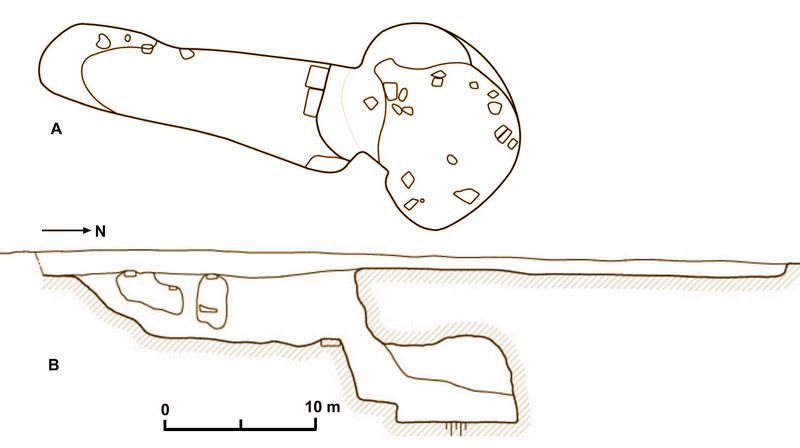 the northern part and steps/platforms along the western and
the southern sides respectively. A secondary dromos for reentering was
built from 2.7 m outside of the southern extremity of the original
tumulus (fig.7).
the northern part and steps/platforms along the western and
the southern sides respectively. A secondary dromos for reentering was
built from 2.7 m outside of the southern extremity of the original
tumulus (fig.7).Fig.7: Plan (A) and section (B) of Kurgan burial Lyavandak-HA-K8.
Though relatively small in size, Lyavandak-HA-K8 has the largest MIN among all of the excavated kurgans in the Bukhara region. There are 12 individuals interred in this burial. Unfortunately, the state of preservation of the human remains is poor. Based on a preliminary bioanthropological analysis, at least 3 of the deceased are c
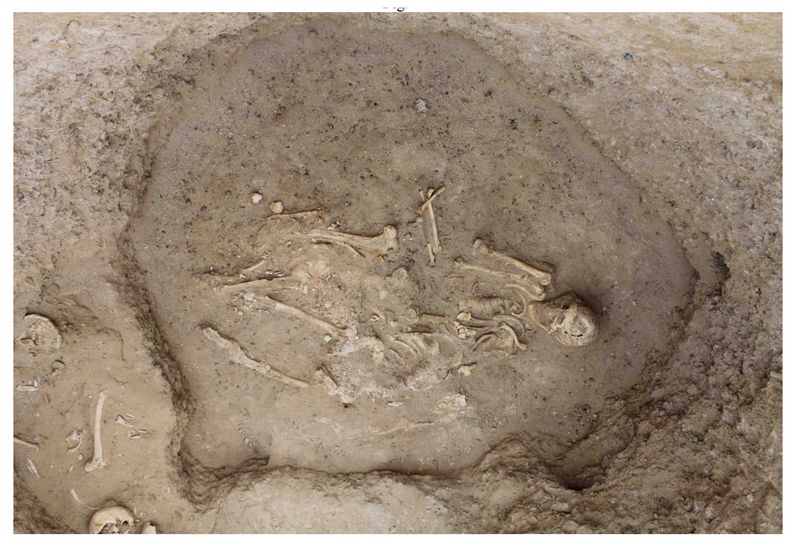 hildren and 5 of them are adults, one of which is a senior male. Altogether the remains of 9 individuals were piled at the bottom of the
northern and western walls of the chamber. The later deceased, i.e. 2
adult individuals with articulate skeletons and 1 child with only a
skull, were buried in the center (fig.8). No containers for bones were found in this burial.
hildren and 5 of them are adults, one of which is a senior male. Altogether the remains of 9 individuals were piled at the bottom of the
northern and western walls of the chamber. The later deceased, i.e. 2
adult individuals with articulate skeletons and 1 child with only a
skull, were buried in the center (fig.8). No containers for bones were found in this burial.Fig.8: Later burials in Lyavandak-HA-K8
All ceramic vessels from Lyavandak-HA-K8 were wheel-made. Three bowls
(LVD-HA-K8-045, LVD-HA-K8-047, LV
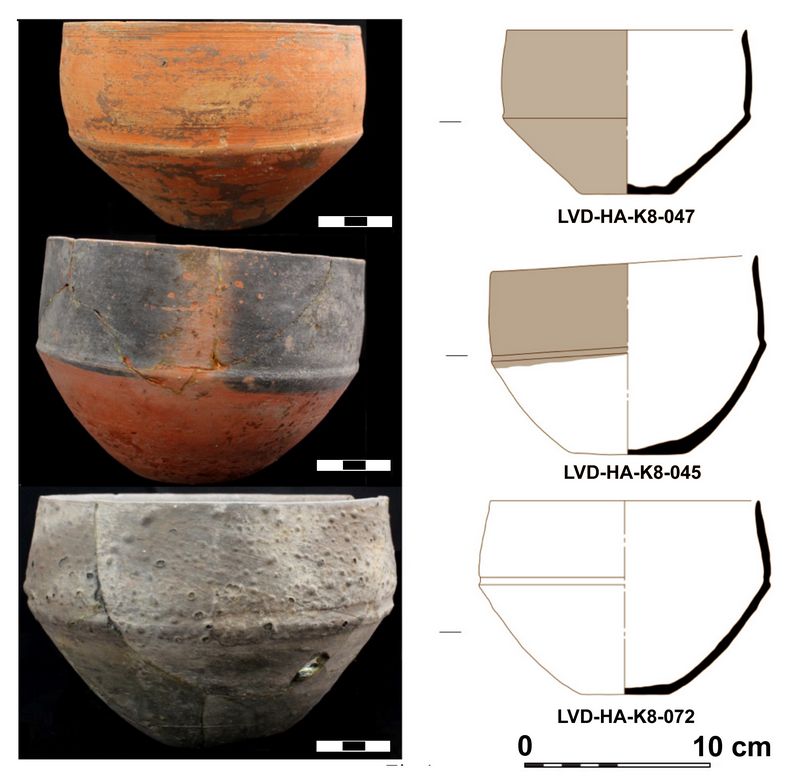 D-HA-K8-072) of the same type found
D-HA-K8-072) of the same type found in Lyavandak-HA-K7 were nested within each other close to the bone pile (fig.9). Interestingly, these bowls differ significantly in quality: the outermost one is gray and unevenly fired with a bumpy exterior surface, whereas the other two in an orange-red color are well-fired with a smooth exterior surface covered by black angobe. It looks as if the gray bowl is an imitation of bowls produced in the oasis. Pottery dated to a later time period (3rd c. CE to 5th c. CE) included fragments of khums (large jars), located at the end of the dromos, i.e. the entrance of the chamber.
Fig.9: Three ceramic vessels found together in LVD-HA-K8..
Other burial goods in Lyavandak-HA-K8 are ornaments and tools, including framed turquoise ornaments comparable to that found in Lyavandak-HA-K7, various glass/paste beads, a bone pin with engraved decorations and a bone spindle whorl. In terms of animal and botanical remains, 2 jaws of dogs were found close to the western wall of the burial, among the piled bones. The flotation of the burial deposit shows no cultivar remains.
3) Kurgan Burial Kiziltepa-SC-K1, Kiziltepa-SC-K2, Kiziltepa-SC-K3, and Kiziltepa-SC-K4 (fig.10).
The tumulus Kurgan Kiziltepa-SC-K1 is of medium size. It was 1.2 m high, 17 m from north to south and 14 m from east to west. The find of a storage jar (a so-called ‘khum’), used as a ceramic bone container, points to the fact that the tumulus was reused at a later period. This type of the ware, with splashed decorations on the exterior surface, is typical for the ceramic complex dating to the 4th to 6th centuries in the region.
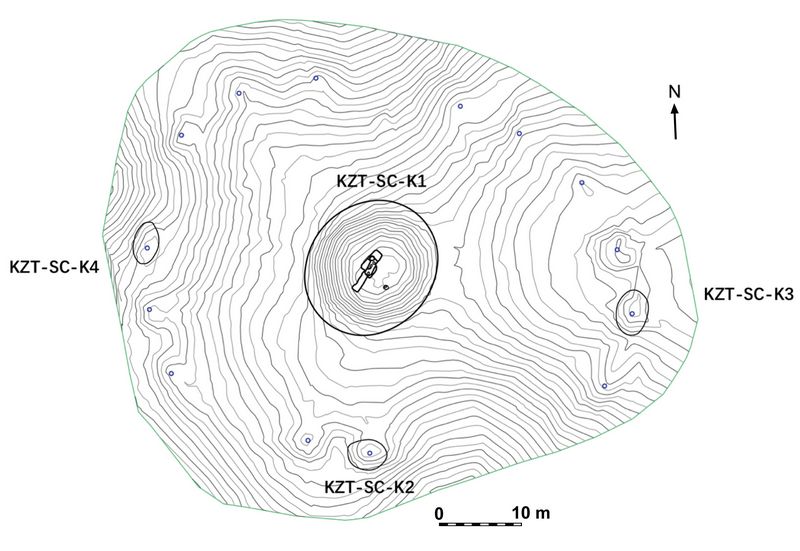 One
complete set of human skeleton of a senior male and a skull of an adult
female were inside the khum. The pinkish surface of the bones shows the
evidence of burns. However, no ash nor charcoal was found inside the
khum. This phenomenon suggests that these bones have been burnt
somewhere else before being collected in the khum.
One
complete set of human skeleton of a senior male and a skull of an adult
female were inside the khum. The pinkish surface of the bones shows the
evidence of burns. However, no ash nor charcoal was found inside the
khum. This phenomenon suggests that these bones have been burnt
somewhere else before being collected in the khum.Fig.10: Plan of Kiziltepa-SC-K1, -SC-K2, -SC-K3, and -SC-K4.
The burial structure beneath the mound also revealed clear evidence for (repeated?) reuse. Originally, this must have been niche (podboi) burial with a step along the western wall and a niche on the eastern side. Later, the burial was altered and turned into a catacomb: the previous niche was sealed by gray mudbricks and a dromos was built in the south; meanwhile, the northern part of the burial was enlarged. Apparently, the burial had been severely looted. Consequently, there are almost no remains of the original inventory, and human bone remains were badly preserved. Several long bones were piled on the step of the previous niche burial. Fragments of bones were scattered in the dromos, burial chamber, as well as among the mudbricks. A few very fragmentary pottery sherds were unearthed from this burial.
Burial Kiziltepa-SC-K1 was surrounded by 12 small tumuli, 3 of which have been excavated in the 2018 season, i.e. Kiziltepa-SC-K2, Kiziltepa-SC-K3, Kiziltepa-SC-K4,which are possibly cenotaphs or ceremonial constructions associated with Kiziltepa-SC-K1. These 3 small tumuli were located to the south, east, and west of Kiziltepa-SC-K1 respectively. The diameters of these small tumuli ranged from 4 m to 5 m, and the heights of them were around 20 cm to 30 cm. No construction nor human remains had been found beneath the mound.
4) Kurgan Burial Kiziltepa-SC-K17
700 meters to the north of Kiziltepa-SC-K1, we discovered a large kurgan (Kiziltepa-SC-K13) with 48 small tumuli as two wings flanking it (
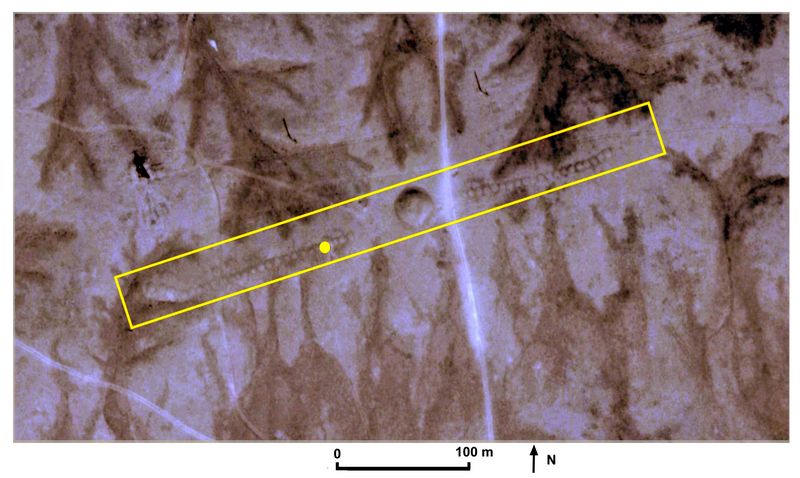 fig.11).
During 2018, we were able to fully excavate only one of these small
tumuli (Kiziltepa-SC-K17) from the western wing .
fig.11).
During 2018, we were able to fully excavate only one of these small
tumuli (Kiziltepa-SC-K17) from the western wing .Fig.11: Aerial view of Kiziltepa-SC-K13, flanked by 48 small tumuli in two wings. The yellow dot shows the location of Kiziltepa SC-K17.
Different from the small satellite tumuli around Kiziltepa-SC-K1, Kiziltepa-SC-K17 is a niche burial. The small tumulus of Kiziltepa-SC-K17 was only 20 cm high and 4 meters in diameter. The burial shaft was located close to the eastern edge of the mound. A step was along the western bottom of the shaft and a niche was opened on the opposite side. Inside the niche, the deceased, most likely a young male covered by a reed mat, was buried in the extended supine position with his head orientated south.
Burial custom in Kiziltepa-SC-K17 is comparable with other niche burials dated to the 2nd c. BCE to the 1st CE in the Bukhara region. What makes this burial distinctive is that the deceased was not facing up, but to the east, namely, the direction of the large kurgan in the center.
In addition, the deceased in Kiziltepa-SC-K17 was styled as a ‘warrior’ with a three-wing arrowhead and an exquisite bone buckle for a belt. One side of this buckle was decorated with engraved concentric circles. Buckles with similar decoration were also found in the other kurgan burials in Bukhara, Bactria and Fergana, and normally buried together with weaponry and/or sheep/goat bones. For instance, in Kiziltepa-K16 in the Bukhara region, a sword, a dagger, an arrowhead, and a bone buckle coexisted alongside the deceased (Obel’chenko 1992). In Bactria, one close parallel was unearthed in Rabat kurgan burial No. 47, a niche burial of a young male, together with a three-wing arrowhead and an iron knife (Central Asia Archaeological Team of the Northwest University et al. 2018). Thus, potentially we are dealing here in Kiziltepa with a funerary ensemble comprising the burials of a nomadic leader and his retinue.
Interestingly, similar buckles were also unearthed from two ‘fortress’ sites excavated in the Bukhara region: Bashtepa (Stark et. al. forthcoming) and Paikent (Mirzaakhmedov and Omel’chenko 2018), located at the western (Bashtepa) and southwestern (Paikent) borders of the Bukhara Oasis. It is very possible that the soldiers, stationed in both fortresses were somehow connected with the deceased in the kurgans.
Conclusions
The investigation of Bukharan kurgan burials in 2018 allows a number of interesting observations and conclusions with regard to the diversity and complexity of borderland societies via the lens of their funerary performance.
To begin with, the fact that kurgan burials were used over a prolonged period suggests that the locus had a particular meaning and importance to the community/communities associated with these burials. Perhaps, later intentionally connected with ‘ancestors’ through the reuse of burials.
In addition, the configuration of a large central burial together with small satellite burials may point to the special sociopolitical rank/status/identity of those deceased in the central tumulus. At least in the ensemble around Kiziltepa-SC-K13 the satellite tumuli contain burials (so far verified only for Kiziltepa-SC-K17). This is of particular interest and opens up very promising research avenues. Are we dealing here with a funerary ensemble constructed for a member of the nomadic elite ruling over Bukhara during antiquity, known from historiographical records and coins?
The analysis of inventory from Bukhara kurgans in 2018 also facilitated our reconstruction of local and interregional exchange networks. The presence of high-quality potteries in the kurgan burials denotes the possible exchange between the deceased and the communities in the oasis. The existence of burial goods prevalent in Central Asia, e.g. bone buckles, glass beads, etc., also positioned these tomb occupants in the network connecting Bukhara with neighboring regions.
Additional Data and Final Conclusions
After the end of our 2018 fieldwork campaign and the submission of our initial report to the Rust Family Foundation we obtained additional data
1) from samples that were collected for AMS C14 analysis in 2018 but had not yet been analyzed at the time of the writing of our initial report;
2) from one more and final season of excavation at the kurgan ensemble of Kiziltepa-SC-K13-17.
In the following we will briefly summarize the main information provided by these additional data.
1) Radiocarbon dates from the 2018 season
During our work in 2018 we were able to collect a total of four samples for AMS C14 dating at the sites of Lyavandak-HA-K7 and Kyzyltepa-SC-K13-17 (fig.12). These samples help us to better date and interpret these two complexes. All samples have been processed by the Centre for Climate, the Environment and Chronology (14 CHRONO Centre) at Queen’s University Belfast. All results were calibrated using OxCal v4.4.2 software (Bronk Ramsey 2009, 2020) and the IntCal 20 curve (Reimer et al. 2020).
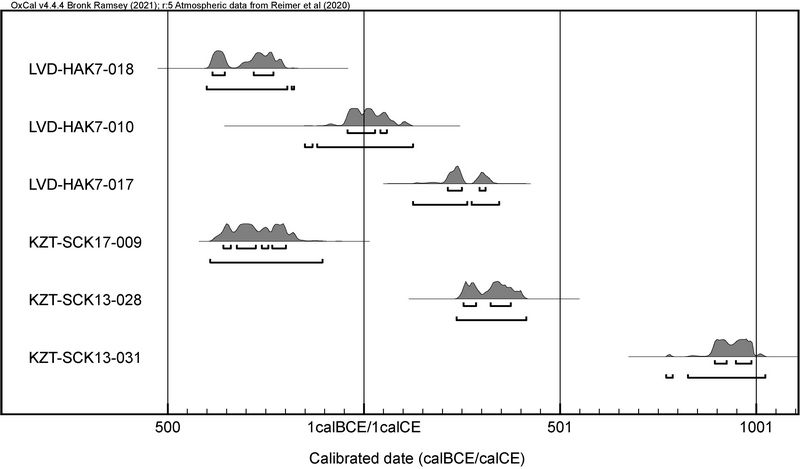
Fig.12: Radiocarbon dates from 2018 samples at Lyavandak-HA-K7 and Kyzyltepa-SC-K13-17.
Three samples were collected from different horizons of kurgan LVD-HA-K7 at Lyavandak. They thus provide us with a chronological framework for the different stages of interment in this kurgan. Sample LVD-HA-K7-018 is a charcoal sample from one of the bricks sealing the first entrance of the chamber, dating with a 99.7% probability between 401-202 calBC, and 68.2% probability between 386-234 calBC. Archaeologically, however, this dates seems too early. It may be the result of using old wood or the secondary usage of bricks (Stark et al. 2020, 48). Charcoal sample LVD-HA-K7-010 was collected inside the second dromos at the section close to the chamber. Its calibrated 2 sigma date (99.7% probability) has two peaks, the first one ranges between 165 to 128 calBC only with 0.3% probability and thus should be excluded. The second peak, with the 98.9% probability range between 122 calBC to 85 calCE is more reliable and seems very plausible. Its 1 sigma date (68.2% probability) points to the second half of the 1st century BC to the first quarter of the 1st century CE. The date of the latest phase of this burial is suggested by sample LVD-HA-K7-017, with 99.3% probability range between 120 to 333 calCE and 68.2% probability range from 140 to 241 calCE. This is extremely interesting and indicates that at least some of the chambers of kurgans were continued to be used well into the second and first half of the third centuries CE – a period for which we have basically no archaeological data from settlements or fortresses within the oasis (Stark et al. 2019, 248-249).
Equally interesting proved the sample KZT-SC-K17-009, taken from the reed mat of satellite burial KZT-SC-K17. At first sight, both the calibrated 2 sigma and 1 sigma date of KZT-SC-K17 provide a relatively large time range: 394 to 155 calBC and 358 to 205 calCE. However, the 1 sigma range shows two distinct probability peaks (326-280 calBC 28.1% and 258-205 calBC 31.0%), of which only the later one is archaeologically plausible. Thus, most likely, this satellite burial – and probably the entire ensemble – dates to the second half of the 3rd century BC. This is a very interesting time, because – as recently shown by A. Naymark – it was at some point around 230/225 BC that the region of Bukharan Sogdiana became independent from the Greeks in Bactria, as some regional political authority in the region of Bukhara now starts to issue its own coinage, imitating early Euthydemus tetradrachms with a sitting Heracles on the reverse (Наймарк 2020, 204). Beyond that, little is known about these newly independent rulers of the oasis, although it seems plausible that they originated from the As and Saka groups mentioned by Justin/Pompeius Trogus Prol. XLI. Thus, our excavations tantalizingly raise the possibility that the monumental central tumulus – after all one of the largest in the entire region – belongs to one of the leaders of those nomads who took power in Bukhara in the second half of the 3rd century BC.
2) 2019 Season of Excavation at Kiziltepa-SC-K13-17
A final season of excavations at the ensemble of Kiziltepa-SC-K13-17 in 2019 revealed no further satellite burials. As the same time we found the burial chamber of KZT-SC-K13 to be almost completely empty (apart from some very small fragments of human bones). Obviously this tomb had been thoroughly plundered already in antiquity. However, our excavation in 2019 greatly expanded our knowledge of how this ensemble (and presumably many other kurgans in the region) continued to be used by later communities, living here many centuries after these tumuli were originally constructed for regional elites. In the mound of KZT-SC-K13, that is in the aboveground part of the original burial construction, we found secondary burials of no less that 12 individuals. At least 8 of them were buried in ceramic vessels, used as bone containers in conformance with burial practices typical for Zoroastrian communities all over Sogdiana during the pre-Muslim Middle Ages. These bone containers date between the 5th and the 7th centuries CE. However, especially interesting and noteworthy are three inhumations and one cremation burial in the same mound. Sample KZT-SCK13-028 from one of these inhumations provided a calibrated radiocarbon date of 211-410 calCE in the 99.5% probability range and 252-344 calCE in the 68.2% probability range, thus likely dating between the middle of the third and the middle of the 4th – a critical period of change in the region between antiquity and the early middle ages that is still poorly understood. Equally intriguing is, in the same mound, a cremation burial with a calibrated C14 date ranging with a 98.6% probability between 801 and 1019 calCE, and 68.2% probability between 895 and 976 calCE (Sample KZT-SCK13-031). Could it be that this burial has something to do with the coming of the Qarakhanid Türks to the region (the first Qarakhanid conquest of Bukhara dates to the year A.D. 999)?
Thus, to briefly conclude, our work at the Bukharan kurgans in 2017-2019 decisively improved our understanding of the ‘live circle’ of these funerary monuments (for more details see Stark et al. 2020; Бан et al. 2020; Wang 2020): On the one hand we are able to better trace the original construction of those tumuli as monuments erected for a regional elite. On the other hand we now also understand their continued use and reuse over many generations – in some cases more than a millenium after their original construction. Clearly, this old funerary landscape continued to have meaning for much later generations; perhaps later communities continued to view those originally buried under the still visible tumuli as ancestors and consequently tried to bury their one deceased close to them, even after burial customs (and with them religious belief systems) had fundamentally changed.
References
Bronk Ramsey, C. 2009. “Bayesian Analysis of Radiocarbon Dates,” Radiocarbon 51: 337–360. https://doi.org/10.1017/S0033822200033865
Bronk Ramsey, C. (2020) OxCal 4.4. https://c14.arch.ox.ac.uk/oxcal/OxCal.html
Buikstra, J. E. / Ubelaker, D. H. (eds.) 1994. Standards for Data Collection from Human Skeletal Remains. Proceedings of a seminar at the Field Museum of Natural History. Arkansas Archeological Survey Research Series 44 (Fayetteville).
Central Asia Archaeological Team of the Northwest University / Institute of Archaeology of the Academy of Sciences of Uzbekistan 2018, “The 2017 Excavation to the Rabat Cemetery in Boysun City, Uzbekistan,” Wenwu 7: 4–30.
Reimer, P. J. / Austin, W. E. N. / Bard, E. et al. 2020. “The IntCal20 Northern Hemisphere Radiocarbon Age Calibration Curve (0–55 cal kBP),” Radiocarbon 62: 725–757. https://doi.org/10.1017/RDC.2020.41
Stark, S. / Kidd, F. / Mirzaakhmedov, D. et al. 2019. “Bashtepa 2016: Preliminary Report of the First Season of Excavations (with an appendix by Aleksandr Naymark),” Archäologische Mitteilungen aus Iran und Turan 48: 219–264.
Stark, S. / Kidd, F. J. / Mirzaakhmedov, J. K. / Wang, Sh. et al. 2020. “The Uzbek-American Expedition in Bukhara. Preliminary Report on the Third Season (2017),” Iran: DOI: https://doi.org/10.1080/05786967.2020.1769495.
Wang, Sh. 2020. Pastoralists at the Crossroads: Late Iron Age kurgan burials in the periphery of the Bukhara Oasis (PhD thesis ISAW, New York University) (New York).
Ван, Ш. / Мирзаахмедов, С. / Штарк, С. 2020. “Раскопки курганов у оазисной стены Кампир Девор Бухарского Согда в 2018 году (Лявандак и Кызыл-тепа),” Археологические исследования в Узбекистане 2018-2019 года: 62–72.
Наймарк, A. 2020. “Монеты нахшабского князя Аштата,” In: А. Искандерова (ed.), История и археология Турана № 5. Посвященный юбилею Рустама Хамидовича Сулейманова (Самарканд): 204–248.
Recent Foundation grants: general Archaeology Grants Program w/map
Copyright © 2022 Rust Family Foundation